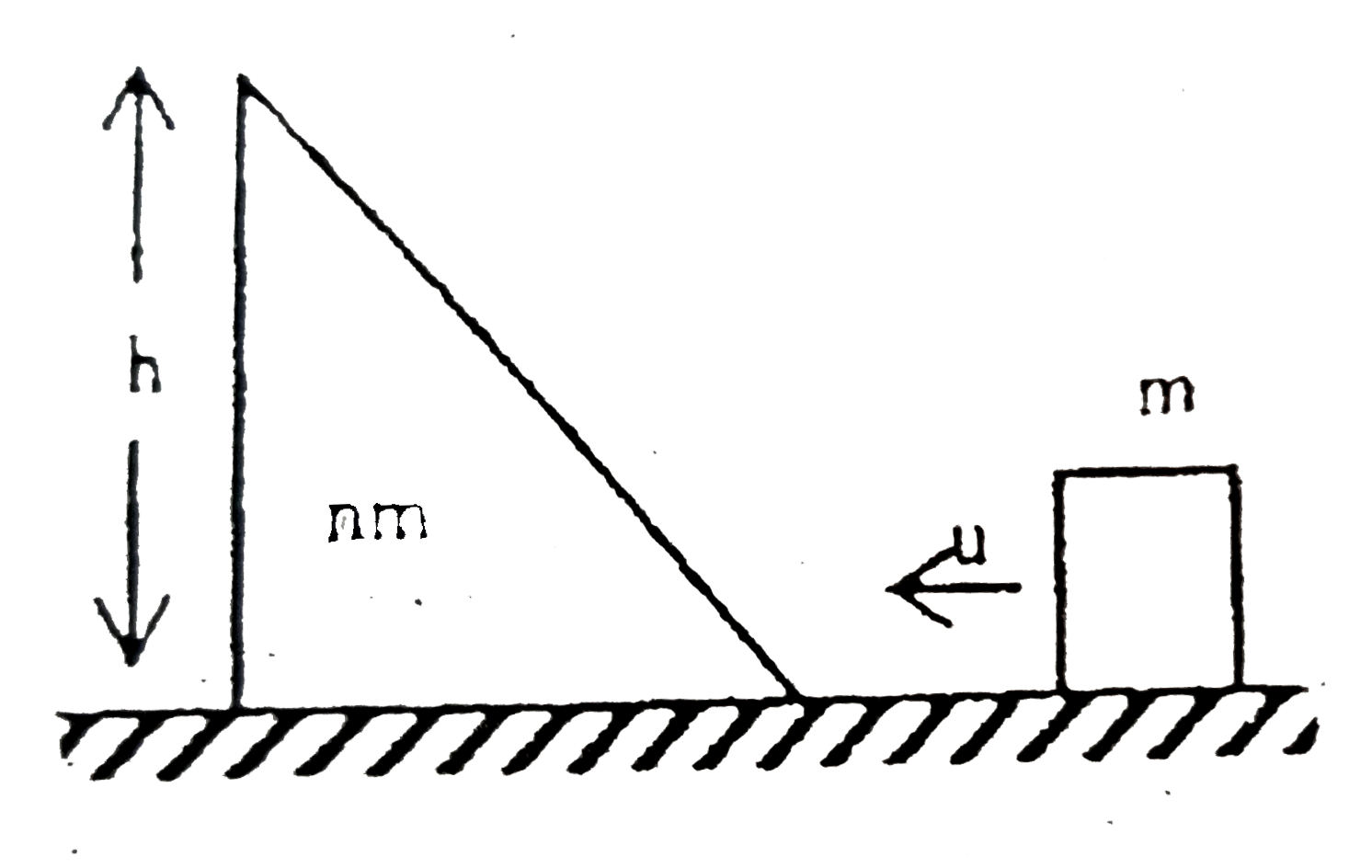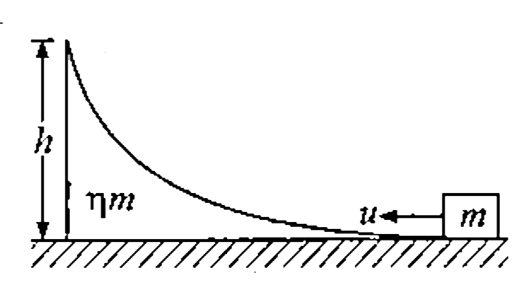A block of mass m is pushed towards a movable wedge of mass nm and height h with a velocity u. All surfaces are smooth. The minimum value of u for which the block reach the top of the wedge is -
Correct option CExplanation:
Related Solutions
A block of mass is pushed towards a movable wedge of mass and height , with a velocity . All surfaces are smooth. The minimum value of for which the block will reach the top of the wedge is

View SolutionA block of mass m is pushed towards movable wedge of mass nm and height h, with a velocity u. All surface are smooth. The minimum value of u for which the block reach the top of the wedge is :
View SolutionA block of mass is pushed towards a movable wedge of mass and height , with a velocity . All surfaces are smooth. The minimum value of for which the block will reach the top of the wedge is

View SolutionA small block of mass m is pushed towards a movable wedge of mass and height h with initial velocity u.All surface are smooth. The minimum value of u for which the block will reach the top of the wedge:

View SolutionA small block of mass m is pushed towards a movable wedge of mass etam and height h with initial velocity u.All surface are smooth. The minimum value of u for which the block will reach the top of the wedge:
View SolutionA block of mass m is pushed towards the movable wedge of mass M and height h , with a velocity v_(0) . All surfaces are smooth . The minimum value of v_(0) for which the block will reach the top of the wedge is
View Solutiona small block of m mass with initial u velocity etam The mass and h are moving towards a movable net height. All surface is smooth. What will be the minimum value of u so that the block reaches the top of the net.
View SolutionA mass of m mass u is pushed towards velocity one nm mass and wedge of height. All the floors are smooth u has minimum value to stop the body at the top of the tree.
View SolutionA ball of mass 'm' is pushed with a velocity u towards a movable wedge of mass 3m which is at rest. Height of the wedge is 60m. Assume all surfaces to be smooth. The minimum value of 'u' for which the block will reach the top of the wedge is ( There is no loss of energy when the ball tries to rise on the wedge ) ( take g = 10 m//s^(2) )
View SolutionA ball of mass 'm' is pushed with a velocity u towards a movable wedge of mass 3m which is at rest. Height of the wedge is 60m. Assume all surfaces to be smooth. The minimum value of 'u' for which the block will reach the top of the wedge is ( There is no loss of energy when the ball tries to rise on the wedge ) ( take g = 10 m//s^(2) )
View SolutionA block of mass 1 kg 'is pushed towards a movable wedge of mass 2 kg and height h=30 cm , with a velocity u=6 m / s . Before striking the wedge it travels 2m on a rough horizontal portion. The velocity is just sufficient for the block to reach the top of the wedge. Assuming all the surfaces are smooth except the given horizontal part and collision of block and wedge is jerkless, the friction coefficient of the rough horizontal part is (Round off the answer to two decimal places) '(##CEN_KSR_PHY_JEE_C08_E01_015_Q09##)'
View SolutionA block of mass 'm' is placed on wedge of mass 'M'. If all the surfaces are smooth

Normal reaction between the wedge and block is
View SolutionA horizontal force F pushes wedge of mass M on a smooth horizontal surface. A block of mass m is stationary to the wedge, then:
View SolutionA block of mass is pushed on a non-movable wedge of mass and height with a velocity . Before striking the wedge it travels on a rough horizontal portion. Velocity is just sufficient for the block to reach the top of the wedge. Assuming all surfaces are smooth except the given horizontal part and collision of block and wedge is jerkless, the friction coefficition of the rough horizontal part is

View SolutionA block of mass is pushed on a movable wedge of mass and height with a velocity . Before striking the wedge it travels on a rough horizontal portion. Velocity is just sufficient for the block to reach the top of the wedge. Assuming all surfaces are smooth except the given horizontal part and collision of block and wedge is jerkless, the friction coefficition of the rough horizontal part is

View SolutionA small block of mass m is placed at rest on the top of a smooth wedge of mass M, which in turn is placed at rest on a smooth horizontal surface as shown in figure. It h be the height of wedge and theta is the inclination, then the distacne moved by the wedge as the block reaches the foot of the wedge is
View SolutionA small block of mass is placed at rest on the top of a smooth wedge of mass M, which in turn is placed at rest on a smooth horizontal surface as shown in figure. If h be the height of wedge and is the inclination, then the distance moved by the wedge as the block reaches the foot of the wedge is
View SolutionA block of mass 'm' is placed on wedge of mass 'M'. If all the surfaces are smooth

Accelaration of wedge 'A' is
View SolutionFixed acceleration to the wedge of mass M along the smooth horizontal surface a = g tan theta This is pushed by and the block of mass m relative to the wedge is projected with a V velocity on the smooth side of the wedge.
View SolutionAll surfaces shown in figure are smooth. Wedges of mass 'M' is free to move. Block of mass 'm' is given a horizontal velocity v_0 as shown. Find the maximum height 'h' attained by 'm' (over the wedges or outside it).
View Solution